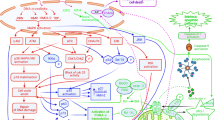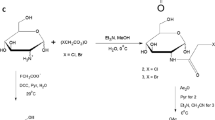Conclusion
From the foregoing it is evident that the experimental profile of miltefosine and alkylphosphocholines is different from that of conventional anticancer agents. Much evidence indicated that the mode of action of alkylphosphocholines was related to plasma-membrane-associated phosphoinositide metabolism. Inhibition of phospholipase C and/or PKC is currently thought to be the main biochemical target of alkylphosphocholines. Considering the great importance of both phosphoinositide metabolism and the regulation of a broad spectrum of cellular functions, including differentiation and invasion, miltefosine could become an interesting new drug. In addition, it may be a tool for further studies into the biochemical pathway of signal transduction in malignant cells.
Similar content being viewed by others
References
Andreesen R, Osterholz J, Luckenbach A, Costabel U, Schulz A, Speth V, Munder PG, Löhr GW (1984) Tumor cytotoxicity of human macrophages after incubation with synthetic analogues of 2-lysophosphatidylcholine. J Natl Cancer Inst 72:53–58
Berdel WE, Himmelmann AW, Danhauser-Riedl S, Steinhauser G, Modest EJ, Rastetter J (1990) In vitro studies in the cross resistance pattern of membrane active lipids (abstract 11.24.03). J Cancer Res Clin Oncol 116:993
Berger MR, Eibl H (1992) Erucylphosphocholine is a second generation alkylphosphocholine (abstract 2483). Proc Am Assoc Cancer Res 33:416
Eibl H, Unger C (1987) Phospholipide als Antitumormittel: Möglichkeiten einer selektiven Therapie. In: Unger C, Eibl H, Nagel GA (eds) Die Zellmembran als Angriffspunkt der Tumortherapie. Zuckerschwerdt, München, pp 1–18
Fleer EAM, Unger C, Kim DJ, Eibl H (1987) Metabolism of ether phospholipids and analogs in neoplastic cells. Lipids 22:856–861
Geilen CC, Haase R, Buchner K, Wieder T, Hucho F, Reutter W (1991) The phospholipid analogue, hexadecylphosphocholine, inhibits protein kinase C in vitro and antagonizes phorbol ester-stimulated cell proliferation. Eur J Cancer 27:1650–1653
Geilen CC, Wieder T, Reutter W (1992) Hexadecylphosphocholine inhibits translocation of CTP: phosphocholine cytidylyltransferase in Madine-Darby canine kidney cells. J Biol Chem (in press)
Grunicke HH, Überall F (1992) Protein kinase C — modulation. Semin Oncol (in press)
Haase R, Geilen CC, Reutter W (1990) Comparison of the effects of the antineoplastic agent hexadecylphosphocholine and of different modulators. of PKC on cell proliferation (abstract). Naunyn-Schmiedeberg's Arch Pharmacol 342:A42
Hilgard P, Stekar J, Voegeli R, Engel J, Schumacher W, Eibl H, Unger C, Berger MR (1988) Characterization of the antitumor activity of hexadecylphosphocholine (D-18506). Eur J Cancer Clin Oncol 24:1457–1461
Hilgard P, Harleman JH, Voegeli R, Maurer HR, Echarti C, Unger C (1989) The antineoplastic activity of hexadecylphosphocholine (HPC) is associated with tumor cell differentiation (abstract 2310). Proc Am Assoc Cancer Res 30:580
Hilgard P, Kampherm E, Nolan L, Pohl J, Reissmann T (1991) Investigation into the immunological effects of miltefosine, a new anticancer agent under development. J Cancer Res Clin Oncol 117:403–408
Hilgard P, Stekar J, Voegeli R, Harleman JH (1992) Experimental therapeutic studies with miltefosine in rats and mice. In: Eibl H, Hilgard P, Unger C (eds) Progress in experimental tumor research, vol 34. S. Karger, Basel, pp 116–130
Hochhuth C, Berkovic D, Eibl H, Unger C, Deonecke D (1990) Effects of antineoplastic phospholipids on parameters of cell differentiation in U937 cells. J Cancer Res Clin Oncol 116:459–466
Hofmann J, Doppler W, Jakob A, Maly K, Posch L, Überall F, Grunicke HH (1988) Enhancement of the antiproliferative effect ofcis-diamminedichloroplatinum(II) and nitrogen mustard by inhibitors of PKC. Int J Cancer 42:382–388
Hofmann J, Überall F, Posch L, Maly K, Herrmann DBJ, Grunicke HH (1989) Synergistic enhancement of the antiproliferative activity ofcis-diamminedichloroplatinum(II) by the ether lipid analogue BM41440, an inhibitor of protein kinase C. Lipids 24:312–317
Lassing I, Lindberg U (1985) Specific interaction between phosphatidylinositol-4,5-bisphosphate and profilactin. Nature 314:472–474
Minana MD, Felipo V, Grisolia S (1990) Inhibition of protein kinase C induces differentiation in Neuro-2a cells. Proc Natl Acad Sci USA 87:4335–4339
Muschiol C, Berger MR, Schuler B, Scherf HR, Garzon FT, Zeller WJ, Unger C, Eibl HJ, Schmähl D (1987) Alkylphosphocholines: toxicity and anticancer properties. Lipids 22:930–934
Nooter K, Vecht B van der, Hogeweg M, Visser J, Hilgard P, Verweij J (1992) The in vitro effects of hexadecylphosphocholine on the murine hemopoietic system (abstract 26). Proceedings, 7th NCI-EORTC Symposium on New Drugs in Cancer Therapy, Amsterdam, March 17–20, p. 65
Parodi MT, Varesio L, Tonini GP (1990) The specific inhibitor of protein kinase C, 1-(5-isoquinolinylsulfonyl)-2-methylpiperazine (H7), induces morphological change and cell differentiation of human neural crest-derived cell lineages. FEBS Lett 269:4–6
Pignol B, Coulomb H, Chaumeron S, Maisonnet T, Vandamme B, Broquet C, Mencia-Huerta JM, Braquet P (1990) Effect of synthetic alkyllysophosphatidylcholine (ALP) on IL-1, TNF and IL-2 productions (absstract 126). Anticancer Res 10:1380
Schallier DK, Brunyneel EA, Storme GA, Hilgard P, Mareel MM (1991) Antiinvasive activity of hexadecylphosphocholine in vitro. Anticancer Res 11:1285–1292
Spruß T, Bernhardt G, Reile H, Schönenberger H, Engel J (1989) Combination therapy with platinum complexes and hexadecylphosphocholine of MXT mouse mammary adenocarcinomas (abstract TH10). J Cancer Res Clin Oncol 115:55
Stekar J, Schumacher W, Nößner G, Kutscher B (1992) D-20133, a novel alkylphospholipid with high antineoplastic activity. J Cancer Res Clin Oncol [Suppl] 118:83
Überall F, Oberhuber H, Maly K, Zaknum J, Demuth L, Grunicke HH (1991) Hexadecylphosphocholine inhibits inositol phosphate formation and protein kinase C activity. Cancer Res 51:807–812
Unger C, Eibl H, Nagel GA, Heyden HW von, Breiser A, Engel J, Stekar J, Peukert M, Hilgard P, Berger M (1989) Hexadecylphosphocholine in the topical treatment of skin metastases: a phase I trial. Contrib Oncol 37:219–223
Unger C, Fleer E, Damenz W, Hilgard P, Nagel G, Eibl HJ (1991) Hexadecylphosphocholine: determination of serum concentration in rats. J Lipid Mediators 3:71–78
Vehmeyer K, Scheurich P, Eibl H, Unger C (1991) Hexadecylphosphocholine-mediated enhancement of T-cell responses to interleukin-2. Cell Immunol 137:232–238
Vehmeyer K, Eibl H, Unger C (1992) Hexadecylphosphocholine stimulates the colony-stimulating factor-dependent growth of hemopoietic progenitor cells. Exp Hematol 20:1–5
Verweij J, Planting AST, Stoter G (1992) Increases in leucocyte and platelet counts induced by the ether lipid hexadecylphosphocholine (HePC) (abstract 31). Proceedings, 7th NCI-EORTC Symposium on New Drugs in Cancer Therapy, Amsterdam, March 17–20, p. 66
Yanapirut P, Berger MR, Reinhardt M, Schmähl D (1991) In vitro investigations on the antineoplastic effect of hexadecylphosphocholine. Arzneimittelforschung 41:652–655
Author information
Authors and Affiliations
Rights and permissions
About this article
Cite this article
Hilgard, P., Klenner, T., Stekar, J. et al. Alkylphosphocholines: a new class of membrane-active anticancer agents. Cancer Chemother. Pharmacol. 32, 90–95 (1993). https://doi.org/10.1007/BF00685608
Received:
Accepted:
Issue Date:
DOI: https://doi.org/10.1007/BF00685608




